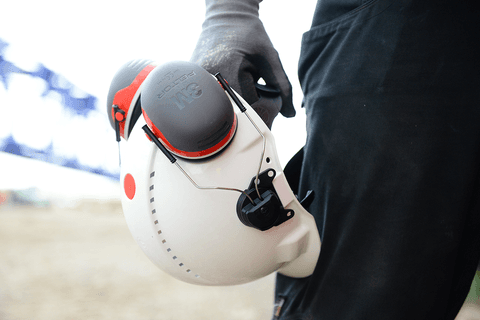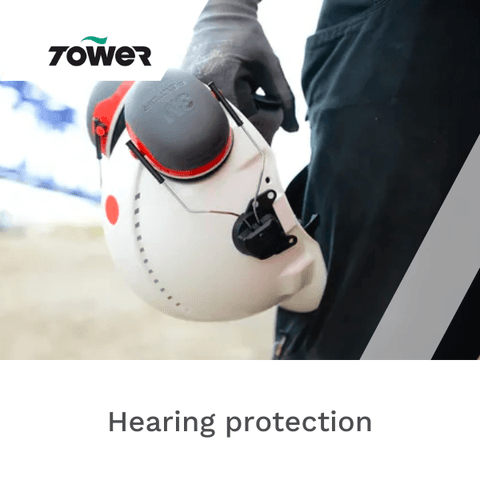How loud is too loud?
Find out everything you need to know about decibels and download our ‘Listen today, hear tomorrow’ fact file with tips and guidance on protecting your hearing at work.

Work ear protection can protect against noise-induced hearing loss (NIHL), one of the most common health issues companies face today.
Around 30% of UK workers are exposed to hazardous noise levels at some point during their day. This could put them at risk of suffering from noise-induced hearing loss (NIHL).
NIHL is permanent and irreversible, but it’s also very preventable.
When you wear Personal Protective Equipment hearing protection, it reduces the amount of sound that reaches your ears, which in turn helps protect your hearing from damage.
Ear protection may be required in industries such as manufacturing, engineering, construction, rail, and utilities and is especially important for workers in loud environments.
Tower Supplies can help you minimise workplace risks with its wide range of high-quality ear PPE; take a look at our Hearing Protection Catalogue for products and more information.
Tower can also carry out an on-site noise survey to help you measure the risks in your workplace.
Once a noise hazard has been identified and a risk assessed, it’s important to follow the hierarchy of controls before using PPE noise protection.
First, try to reduce the noise, choose quieter equipment, use silencers, find ways to reduce the noise itself, or adapt the workplace to move the noise away.
If the noise cannot be reduced or eliminated, then PPE ear defenders will need to be worn.
Legislation dictates that if sound levels reach 80 decibels, hearing protection is recommended but not mandatory. When sound levels exceed 85 decibels, hearing protection must be made available and worn.
But, if you cut out too much sound, it can make communication difficult: offer too little protection and you won’t filter out the damaging sound. It’s a complicated area. That’s why talking to a trusted expert supplier is crucial to fully understanding PPE ear protection.
In 2021, the Health and Safety Executive reported 14,000 new cases of work-related hearing loss.
This includes permanent hearing loss and tinnitus (recognised by the World Health Organization as being the third most serious non-fatal medical condition) which is why wearing ear defenders is so important.
It’s also important for employees to understand the importance of ear protection for work and to receive training and information on how ear defenders work; why it's important to wear them; and how to properly fit, maintain and use their PPE hearing protection.
Tower can support you in sourcing the best personal protective equipment for your hearing protection.
The World Health Organization (WHO) identified NIHL as the most common permanent and preventable injury in the world. The WHO also recognised tinnitus as the third most serious non-fatal medical condition.
In 2018, new PPE European Regulation 2016/425 came into force to provide greater protection for PPE users. This included moving hearing protection up to Category III, the highest risk category, reserved for PPE designed to protect against serious or irreversible damage to health.
Tower offers a comprehensive guide to the three categories of PPE, detailing their implications for manufacturing, design, and regulation. It explains how increased safety requirements and risk levels are closely tied to the complexity of PPE design.
Find out everything you need to know about decibels and download our ‘Listen today, hear tomorrow’ fact file with tips and guidance on protecting your hearing at work.

Ears are a vital part of the human body. They are extremely sensitive and contain the body’s smallest bones. Therefore, choosing the correct work ear protection is essential to avoid consequences such as tinnitus, acoustic trauma, temporary or complete hearing loss, or industrial/occupational deafness.
There are two main types of PPE hearing protection that you can buy:
As the name suggests, this type of PPE plugs your ear canal and cuts down on the sound pressure reaching your ear drum. When used correctly, ear plugs are the most effective form of ear protection.
Ear plugs can also be corded and strapped. Some are disposable and some can be reused and worn again after washing. But ear plugs should never be shared between workers, even after cleaning, to avoid infections.
Also known as ear defenders, earmuffs work in a different way to ear plugs. Instead of being worn inside the ear, earmuffs are worn over the entire ear to "muffle" the sound by sealing against the head with an over-head band.
Some earmuffs don’t use a headband and clip to the side of a hard hat. Remember that earmuffs don’t block the sound entering the ear like ear plugs do, so it’s essential you get a good seal between the cups and the head.
There’s a lot to consider when choosing and maintaining hearing protection PPE for your workplace. Here are seven key things to remember. But if you are ever unsure, talk to your trusted supplier.
• Control the risk – Look at the task and the working environment. Work through the hierarchy of controls whilst measuring the level, frequency, and pitch of the noise.
• Don’t over protect – Cutting out noise comes at a cost, as this can cause isolation, an unwillingness to wear them, and the inability to hear alarms and communications.
• Accommodate the wearer – Ensure the ear protection is comfortable and suitable. Consider hygiene, combining them with other PPE, and worker performance.
• Educate employees – It’s the responsibility of the employer to ensure that anyone that is given PPE knows how to use it, when to wear it, how to maintain it, and when to replace it.
• Availability to employees – PPE must be made readily available to anyone who needs it by the employer.
• Maintenance – All types of ear protection should be properly maintained and kept in good, clean, and undamaged condition by the employee.
• Check before use - Ensure that the cups and headband are not cracked or split, the foam has not been deformed, and the ear cushions are clean and ready for use.
Make sure you're up to date and in the know about the evolution of ear protection standards and what to consider when choosing ear defenders, ear muffs, and accessories.

The Control of Noise at Work Regulations 2005 (Noise Regulations 2005) requires employers to prevent or reduce risks to health and safety from exposure to noise at work. The Regulations require employers to:
• Assess the risks to employees from noise at work.
• Take action to reduce the noise exposure that produces those risks.
• Provide employees with hearing protection if you cannot reduce the noise exposure enough by using other methods.
• Make sure the legal limits on noise exposure are not exceeded.
• Provide your employees with information, instruction and training.
• Carry out health surveillance where there is a risk to health.
Tower Supplies is an award-winning and trusted supplier of high-quality PPE products.
In addition to ear protection for the workplace, Tower Supplies offers a diverse range of protective PPE products offering solutions for a range of protective wear from eye protection to hand protection.
If you have any questions about our PPE products or have any general PPE queries, contact the Tower Supplies team today!